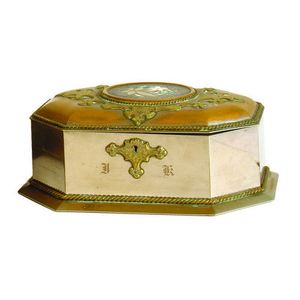French Pietra Dura Sewing Casket with Silver Plate & Brass
You must be a subscriber, and be logged in to view price and dealer details.
Subscribe Now to view actual auction price for this item
When you subscribe, you have the option of setting the currency in which to display prices to $Au, $US, $NZ or Stg.
- Mother-Of-Pearl - Mother-of-pearl, technical name "nacre", is the inner layer of a sea shell. The iridescent colours and strength of this material were widely used in the nineteenth century as an inlay in jewellery, furniture, (especially papier mache furniture) and musical instruments.
In the early 1900s it was used to make pearl buttons. Mother-of-pearl is a soft material that is easily cut or engraved.
Nowadays it is a by-product of the oyster, freshwater pearl mussel and abalone industries. - Pietra Dura / Florentine Mosaic - Pietre dura, also known in English as "Florentine mosaic" is a decorative art that originated in Renaissance Italy and involves the creation of intricate, multi-layered inlaid designs using a variety of different coloured stones. The name "pietre dura" is Italian for "hard stones," and refers to the use of hard, durable materials such as marble, agate, jasper, and other semiprecious stones in the creation of the designs.
The origin of pietre dura can be traced back to ancient Rome, where the technique was used to create intricate inlaid designs for mosaic floors, walls, and other architectural elements. During the Renaissance, the technique was revitalized in Italy and became particularly associated with the city of Florence. The court of the Grand Duke of Tuscany, Cosimo I de' Medici, was a major patron of pietre dura and employed many of the leading artists and craftsmen of the time to create a wide range of objects, from small items like jewelry boxes and vases to large panels and furniture.
In the 19th century, pietre dura was used to create a wide range of decorative objects, from furniture and decorative panels to small items like jewelry boxes, vases, and picture frames. During this time, the technique was particularly popular in Europe, where it was used to create elaborate pieces of furniture and other decorative objects for the wealthy and aristocratic classes.
In addition to traditional pietre dura objects like cabinets, tables, and vases, the 19th century saw the development of new forms of pietre dura, such as book covers, cigar boxes, and other small items. This was largely due to the advent of new, more affordable production techniques and materials, which allowed for the creation of pietre dura objects on a larger scale and at a lower cost.
This item has been included into following indexes:
- boxes, material or decoration
- jewellery and trinket boxes - silver plate items 61
Visually similar items

A small silver plated Arts & Crafts table clock, the circular dial with Arabic numerals, the base with elaborate pierced scroll designs, arched top, oblong plinth base. Some wear. Working order. Height 20 cm

Very rare antique mid 19th century pull repeat desk clock attributed to Thomas Cole, of engraved arched design, fitted with a folding carry handle, the dial engraved and pierced in three layers, with a seated female figure amongst scrolling foliage & bell

A 19th century Japanese Satsuma lidded jar, Meiji period, the four sided jar featuring various flora, butterflies and entertainment scenes, signed, 6 x 6 x 9 cm.

A 19th century French ormolu and champleve enamel small bombe mantel clock, the case in decorative powder blue dominated enamel florals, the white enamel dial with painted floral swag and Arabic numerals, enclosing diamante bezel, the French movement worki
